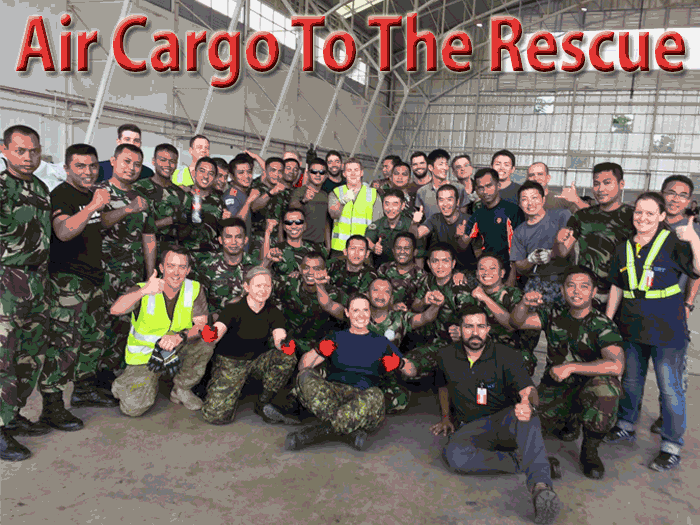 |
 The
world looked on in horror in late September when the central region around
Palu on the Indonesian island of Sulawesi was devastated by an earthquake
and tsunami. And then the world quickly turned away again, exhausted by
natural disasters and titillated by reality TV and politics, often at
the same time. The
world looked on in horror in late September when the central region around
Palu on the Indonesian island of Sulawesi was devastated by an earthquake
and tsunami. And then the world quickly turned away again, exhausted by
natural disasters and titillated by reality TV and politics, often at
the same time.
As a result, it is not widely appreciated
just how effective the air freight relief effort was in helping the people
of Sulawesi. FlyingTypers
tracked down Chris Weeks, Director of Humanitarian Affairs for Deutsche
Post DHL, one of the leading figures in the humanitarian effort. We asked
him what went so right at Palu and what lessons can be applied to future
disaster relief planning.
Air Cargo
Did Not Forget
A 7.5 magnitude earthquake struck the Indonesian
island of Sulawesi on Friday, September 28 at about 6pm. This was followed
by a tsunami with waves up to 6m high triggering a series of horrific
mudslides around Palu. Over 2,000 people are known to have died in Sulawesi
as a result of the natural disaster and over 200,000 were displaced.
The world’s attention briefly focused
on the awful images of villages being submerged by mud and water in the
immediate aftermath of the tragedy. And then Palu largely disappeared
from global media.
Fortunately, in the days that followed the
traumatic events of 28 September not everybody turned their back. A huge
humanitarian operation was quickly up and running with air cargo handling
and relief flights at its core. As FlyingTypers has previously
reported, most notably from Nepal after the earthquakes of 2015, such
operations rarely go smoothly. Palu, it transpires, proved a rare example
of how air cargo can deliver when and where it is most needed.
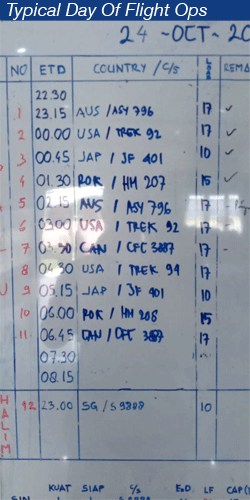 Air
Cargo Delivered Air
Cargo Delivered
At the center of the relief effort was Deutsche
Post DHL Group’s Disaster Response Team, which deployed October
4-26 at the request of the Indonesian National Board for Disaster Management
(BNPB) and the ASEAN Coordinating Centre for Humanitarian Assistance on
Disaster Management (AHA Centre).
Leading the response, as he so often does,
was Chris Weeks, Director of Humanitarian Affairs for Deutsche Post DHL,
a veteran of DHL deployments including the Asian tsunami, Hurricane Katrina
in the United States, Cyclone Nargis in Myanmar, the 2011 floods in Pakistan,
and earthquakes in Kashmir, Peru, Haiti, Chile, Nepal and the Philippines.
He told Flying Typers that Palu
proved a very different experience compared to most relief operations.
“Usually, massive natural disasters are followed by chaotic logistics
as Search and Rescue, medical and general relief teams try to get into
the theatre to help those stricken by the earthquake, hurricane or cyclone,”
he said. “Meanwhile residents desperately try to get out with whatever
they can carry.
“This time it was different. The Government
of Indonesia was determined not to have a repeat of the response to the
2004 Banda Aceh tsunami where UN and Red Cross Aid agencies, NGOs, foreign
militaries and media crews rushed in and caused a massive logjam of people
and donated goods. The situation was challenging for the national agencies.”
Indonesia
Proritized
As a founding member of ASEAN, in 2011 Indonesia
helped set up the AHA Centre (ASEAN Humanitarian Assistance) with its
HQ in Jakarta. This organization is responsible for humanitarian response
within the 10-member nations and has advocated more self-sufficiency rather
than reliance on the UN agencies and others for help. For example, this
year, after the dam flood in Laos and the Lombok quake in Indonesia, all
foreign help was shunned.
Weeks said that after the Sulawesi earthquake
the same principle was adopted, meaning very few Search and Rescue crews
made it to the scene as the Government declared ‘no foreigners’
and insisted it could cope through its AHA system.
“For the relief phase, to a large
extent the policy worked from a logistics and transportation perspective,”
he said. “As the airport in Palu is small anyway and the control
tower, terminal building and runway had been damaged, Balikpapan in Kalimantan
was designated as the relief airport.
“The Government specified exactly
what was needed and allowed - transport assets and shelter items, no medical
teams or supplies. Again, no unsolicited goods was the message clearly
put out to the humanitarian world which had an effect on the relief effort.”
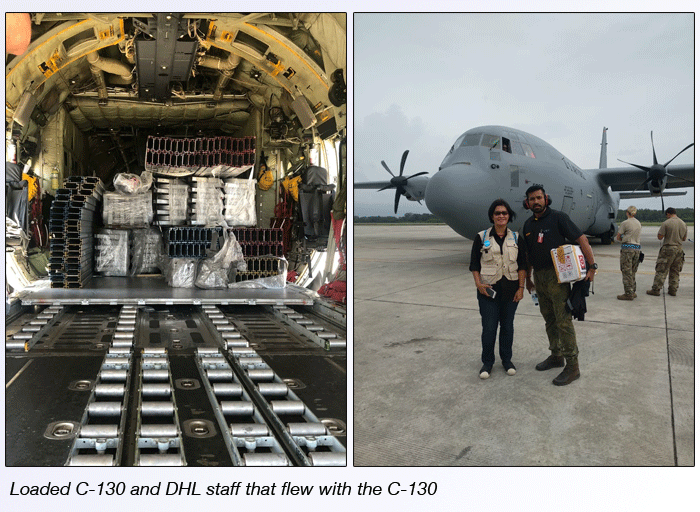 |
The plan drawn up instead saw donated goods
sent to Balikpapan airport by commercial or military carrier to be off-loaded,
customs cleared and checked for suitability. Hangar C was cleared and
designated as the main Hub for international relief goods, and the base
for the foreign C-130s and crews - christened ‘the Air Angels’
- donated by USA, Canada, Japan, Korea, Australia, Singapore, India and
NZ.
“Both AHA and BNPB were present in
the Hangar and made themselves responsible for coordination between the
host nations, donors and customs,” said Weeks.
 |
Seamless
Clearance
“As all crews were using the same
aircraft type and sharing military 463L pallets this meant that incoming
cleared goods could be quickly transferred from PMCs - cookie sheets -
to 463Ls by DHL and the ground handling agents, JAS and Angkasa Pura.
“After checking priorities with BNPB,
DHL then posted, on a flipchart, the pallets available for the seven crews
to choose at a regular 4pm meeting. Having chosen their cargoes, the crew
leaders went to BaseOps, an Indonesian Air Force base, to get a briefing
and choose their slot times for the following day. This process, together
with a Messenger App group for immediate dissemination of information,
worked really well for 23 days of operations.
“USAF had several large forklifts
and took loaded 463s from the Hangar to the aircraft for loading under
the supervision of loadmasters. In Palu, under a blistering sun and/or
torrential rain, the pallets were received by more U.S. forklifts and
ground handlers from the USAF Crisis Response Group out of Guam.”
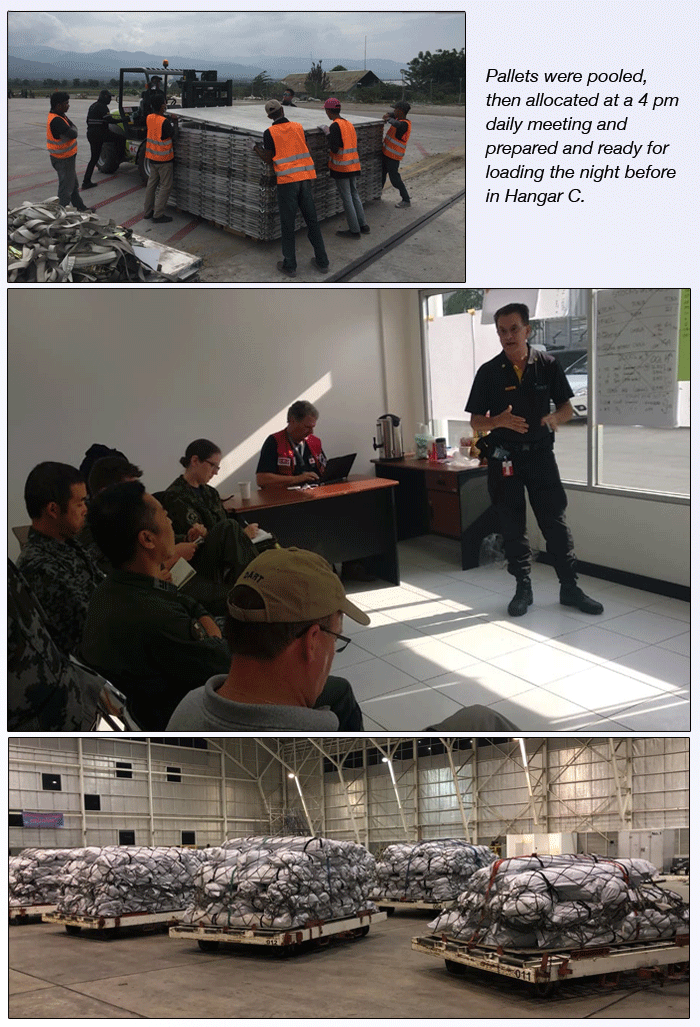 |
Stellar Disaster
Response
DHL was one of a few private companies to
get involved with 26 staff from six countries volunteering to fly to Indonesia
to help in the relief effort. The DHL Disaster Response Team (DRT) established
a “control tower” in BPN (Balikpapan airport on the neighboring,
but still distant, island of Kalimantan) and also served as a ground handling
agent with U.S. CRG in PLW (Palu).
In the latter role DRT used two rough terrain
forklifts brought in by the UK government and donated to IFRC. IFRC then
lent them to DHL at PLW for the whole duration of the relief operation.
Their main role was taking relief goods off the 463L pallets and organizing
onward movement to the United Nation’s World Food Programme (WFP)
storage units, or to BNPB locations for future distribution.
“The flow of relief goods in the first
10 days was mostly G2G - Government to Government - donations from China,
Japan, U.S. amongst others,” said Weeks. “It was nearly all
‘clean’ freight, easy to handle, well packed, homogenous units
with a common owner.
“Then there was a lull, as the G2G
freight reduced and before the UN agencies - notably UNICEF, UNHCR and
WFP - Red Cross and BINGOs, Big International NGOs, got their act together
and worked out how to get their donations accepted by BNPB.
“During this quiet period, the C-130
crews flew sorties BPN—HLP (Halim Air Base, Jakarta)-PLW-BPN to
pick up 200 tons of locally donated goods. Then, on a final push by the
humanitarians, large shipments of tents, tarpaulins and other shelter
items started to arrive in BPN mostly via KUL by commercial carriers right
up to the deadline set by BNPB at midnight on October 24th. This gave
the coalition two further days to clear the Hangar of goods needed in
Palu, before everyone headed home.”
Eight nations participated in the coalition:
the U.S,. Canada, Japan, Singapore, Korea, Australia, India and New Zealand.
DHL’s Disaster Response Team helped to process nearly 3,500 tons
of cargo to ensure quick aid to Sulawesi survivors between 4th and 26th
October.
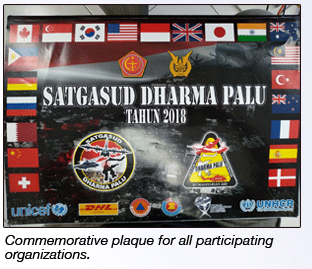 Lessons
Learned Lessons
Learned
Weeks told FlyingTypers the key
lessons learned during the Sulawesi relief effort were the following:
“The 10 South East Asian countries
in ASEAN will continue to adopt a more independent
stance in future, relying on friendly regional military
forces to help with transport and direct aid, with only a few key NGOs
contributing. Indonesia was determined not to have a repeat of the 2003
tsunami situation where 450 NGOs were competing to help victims. This
episode has stuck with them, and they proved their model can work. So,
having good relations and contacts with AHA will be key for operating
in the region in the future, and DHL will be signing a MoU with them in
the New Year.
“’Tat’
is out. There is no longer any place for second hand clothes
and small inappropriate donations. About time!
“Wait your turn. Stronger
national control means there is a more structured approach
as to what commodities come and when, rather than a free for all. This
is a campaign that DHL is supporting through a UN ICAO/OCHA [the International
Civil Aviation Organisation and the United Nations Office for the Coordination
of Humanitarian Affairs] initiative to create a voluntary prioritisation
system for relief aircraft.”
SkyKing
|
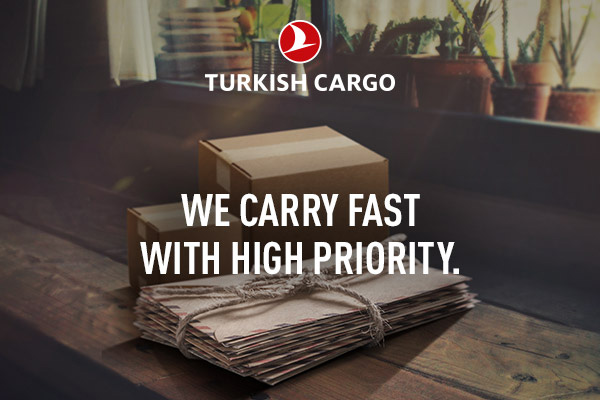



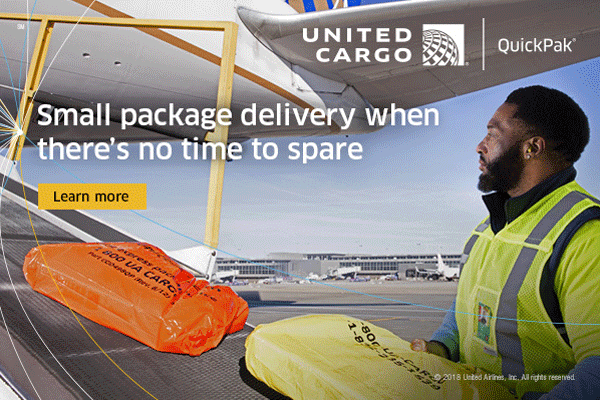
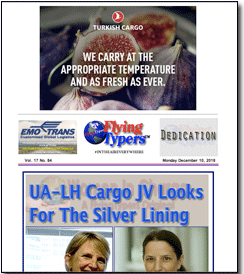 Vol.
17 No. 84
Vol.
17 No. 84 Vol.
17 No. 85
Vol.
17 No. 85